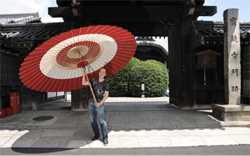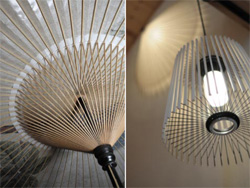Home > Highlighting JAPAN > Highlighting Japan SEPTEMBER 2011 > Hiyoshiya: Reinventing the Umbrella
Highlighting JAPAN
JAPAN BRAND
Hiyoshiya: Reinventing the Umbrella
Gavin Blair visits a small company in Kyoto whose president has brought one of Japan’s most iconic traditional products not only into the twenty-first century but also to countries around the world.

Kotaro Nishibori, president of Hiyoshiya, holds a nodate-gasa parasol for use in the open-air tea ceremony. In the background is Hokyo-ji temple, which is located directly opposite the Hiyoshiya studio. The temple allows Hiyoshiya to use its grounds to dry the umbrellas under sunlight after coating with linseed oil.
Credit: ALFIE GOODRICH
Wagasa are painstakingly handcrafted from a single piece of bamboo and covered with washi (Japanese paper) to create the individual design of each umbrella. Wagasa have been made this way for almost a thousand years since they were introduced from China, though the waterproofing of umbrellas with linseed oil and their wide use as rain umbrellas is a relatively recent development, dating back a couple of centuries.
“There are three main kinds of wagasa: the parasol, the rain umbrella, and the larger kind used for tea ceremonies and other such occasions,” explains Nishibori.
Although Nishibori is the fifth-generation head of Hiyoshiya, he came to the field from outside, having married the daughter of the previous head of the business. He was a local government worker at the time and had no notion of how to run a traditional Japanese artisan’s company. However, after having seen, and come to appreciate the craftsmanship of wagasa, he decided—against many of his friends’ advice—to take over the business twelve years ago.

Kotaro Nishibori utilizes the open-close mechanism of the design features of the wagasa umbrella (left) in lampshade designs such as this one (right) made of steel and plastic.
Credit: ALFIE GOODRICH
In addition to creating lamps from the traditional bamboo and washi paper, Nishibori has created a series made from steel and plastics, utilizing the shape and design of wagasa. As well as being bought for private houses, the lampshades are also used in restaurants, cafés and hotels both in Japan and abroad.
Nishibori learned by trial and error when trying to make products for overseas markets. He explains that his first set of lamps was deemed too small when he took them to Europe to show people. He was also told that they were too bright, so he made larger sizes with lower wattage light bulbs. The lamps are now sold in twelve countries and represent about 40% of Hiyoshiya’s sales, being particularly popular in central Europe where they have won design awards.
“We exhibited in Shanghai last year and thought maybe our products would be too expensive for the Chinese market, but that turned out not to be the case at all,” says Nishibori.
“Even in Japan, when people do want to buy a wagasa, they often don’t know where to buy it. The Internet is really useful in this respect, and the number of people accessing our homepage has grown enormously since we launched it in 1998,” says Nishibori.
Having studied abroad after high school while staying with relatives who had emigrated to Toronto, Canada, Nishibori learned to speak English, which has proved useful as his overseas business has increased. He has also collaborated with European designers on new ranges of products and traveled around the world to exhibitions with Hiyoshiya.
According to Nishibori, the only way to protect the traditional artisan skills of making and repairing wagasa is to take them and put them to use creating products that will sell in the modern global marketplace.
“There’s a lot of talk about tradition, but nothing started life as traditional; what is now thought of as traditional was once new,” points out Nishibori. “My philosophy is that tradition is a continuing process of innovation.”
© 2009 Cabinet Office, Government of Japan






